We are posting here the second part of a four-part series on the 1934 Minneapolis general truck drivers’ strike. Part one was posted on August 26.
The leaders of Minneapolis Teamsters Local 574
 Vincent R. Dunne (left) and Carl Skoglund
Vincent R. Dunne (left) and Carl SkoglundIn 1915, Vincent Dunne met Carl Skoglund in Minneapolis. Skoglund, a Swedish immigrant, had joined the Socialist Party in 1914. Dunne had been a member of the IWW, and Skoglund introduced him to Marxism. They would both rally to the Russian Revolution and later join the Communist Party. They had both passed through many of the great struggles of their time in Minnesota.
In 1924, they met James P. Cannon, a leading member of the Communist Party, who was passing through Minnesota on one of his tours for the International Labor Defense. Impressed with Cannon, they approached him four years later, in 1928. Both were deeply troubled by the expulsion of Leon Trotsky and Gregory Zinoviev from the Russian Communist Party. Cannon, also troubled, could only reply, “Who am I to condemn the leaders of the Russian revolution.” [10]
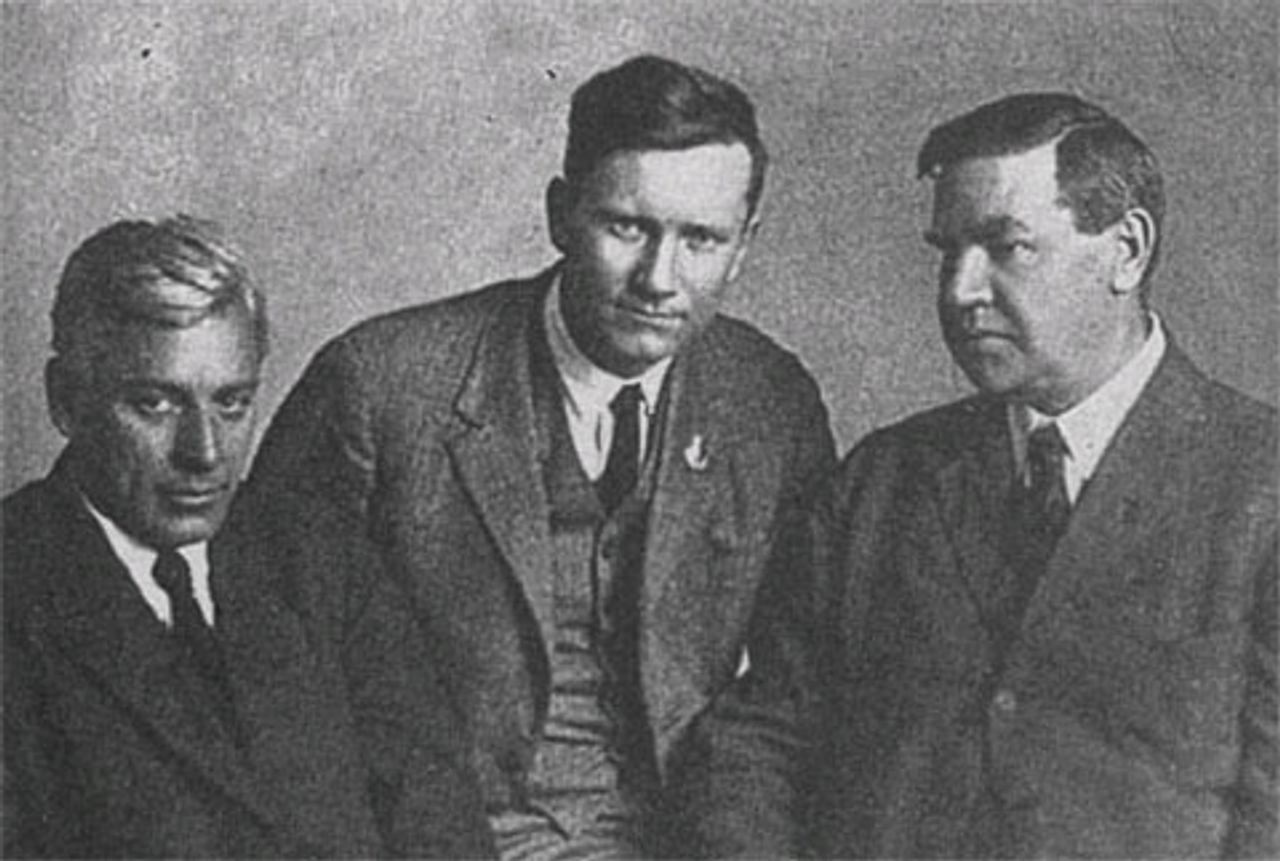 1922: Max Eastman, James P. Cannon and William Haywood in Moscow
1922: Max Eastman, James P. Cannon and William Haywood in MoscowLater that year, Cannon traveled to the Soviet Union for the Sixth World Congress of the Communist International. It was there he obtained Leon Trotsky’s document “The Draft Program of the Communist International: A Criticism of Fundamentals.”
The document laid bare the anti-Marxist orientation of the Stalin-Bukharin faction, which failed to proceed from the international contradictions of capitalism and falsely believed that socialism could be constructed within the boundaries of the Soviet Union. Trotsky maintained that only on the basis of an international perspective and world revolution could the Soviet Union be defended and advance towards socialism.
The document in a number of places revealed how the Stalin faction had subordinated the working class in China, Britain and other countries to non-proletarian forces. In an extended section, the document derided the opportunist policies pushed by the Stalin faction in relation to farmer-labor parties in the United States, where farmers were advanced as an independent revolutionary force. Trotsky insisted that oppressed sections of the middle class could not play an independent revolutionary role and had to be led by the working class armed with a Marxist program.
Cannon returned to New York and immediately set about to organize an opposition within the Communist Party of the United States based on Trotsky’s perspective. Within a short period of time, he and his adherents were expelled by his opponents in the American CP for their support of Trotskyism. The CP then issued directives that other branches and districts of the Communist Party blindly endorse the expulsion of Cannon.
In Minneapolis, both Carl Skoglund and Vincent Dunne were expelled from the CP when they balked on voting for the expulsion, and instead asked for more information. Both had personal experience with expulsions, having been turned out of the AFL in 1926 during the bureaucracy’s “Red Purge.” Dunne, who had been a candidate for the Farmer-Labor Party, was also expelled from that organization earlier in 1928. In the end, more than two dozen Minneapolis CP members were expelled and a majority joined the opposition after becoming familiar with Trotsky’s program.
The Cannon group ultimately established the Left Opposition in the United States under the name Communist League of America (CLA). During this period, the followers of Trotsky were seeking to win the Communist parties back to a Marxist and internationalist perspective in a struggle against the Stalinist leadership. This period was rich in theoretical development for the CLA.
“They spent a good deal of time studying the Marxist classics and discussing how to shape their revolutionary course,” related Farrell Dobbs, who would join the CLA in the lead-up to the 1934 strike. [11]
Craft unionism versus industrial unionism
A major impediment to the movement of the working class was the AFL bureaucracy. The growth and changes in the structure of capitalism, principally the qualitative development in the division of labor brought on by the assembly line, made the AFL policy of dividing workers in plants into separate crafts reactionary.
Teamsters International President Daniel Tobin personified the right-wing conservative craft bureaucrat. In 1934, his hatred for the Trotskyist leaders of Local 574 boiled over when they brought truckers’ helpers and warehouse, or “inside,” workers into the local union fold. Tobin considered unskilled or non-driver workers “rubbish.” As the upsurge of the workers in 1933 began, Tobin stated, “The scramble for admittance to the union is on...we do not want the men today if they are going on strike tomorrow.” [12]
In 1934, the Trotskyists did not hold any official positions within Local 574. Bill Brown, the president of the local, was an exception to the typical bureaucrat. He welcomed the collaboration of the Trotskyists.
But the majority of the officials in the union followed Tobin. The union membership in the coal yards on the eve of the strike was a mere 75 workers, and these members were the result of a backroom deal with a small group of coal dealers, who agreed to the closed shop in return for the union drumming up business for them among residential customers. The union officials were satisfied with this state of affairs and not inclined to organize other workers.
Prelude to 1934
In 1930, Floyd B. Olson was elected as the first Farmer-Labor governor of Minnesota. During his campaign, he had set up “All-Party Committees for Olson” in an effort to obtain support from sections of the Democrats and Republicans. Upon taking office, patronage was handed out to those who had supported him.
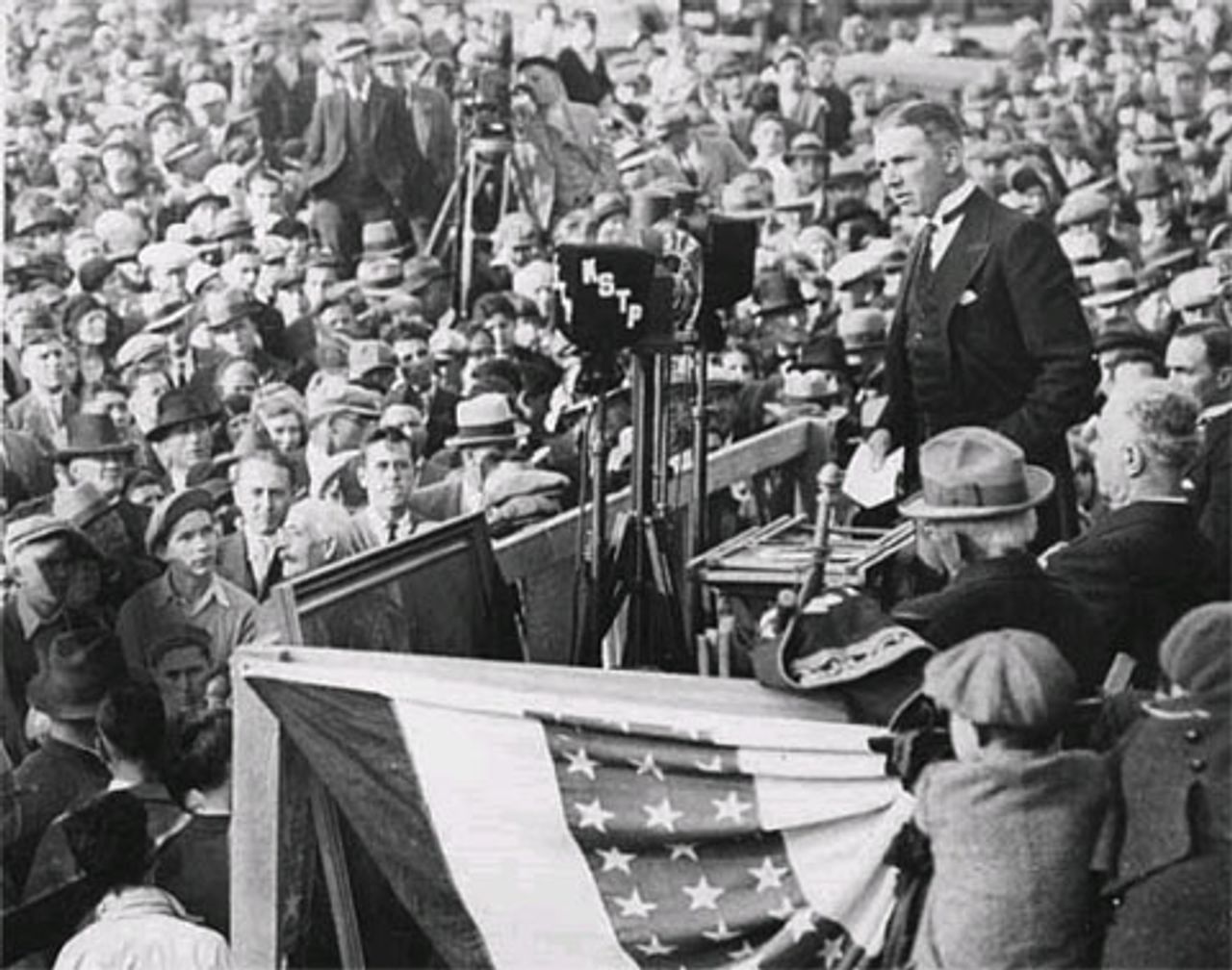 1931: Minnesota Farmer-Labor Party Governor Floyd B. Olson
1931: Minnesota Farmer-Labor Party Governor Floyd B. OlsonOne of the first struggles that rocked the Midwest was the 1932-1933 strike by the National Farm Holiday Association. Between 1920 and 1930, farm prices had fallen. Gross annual farm income dropped from $15.4 billion to $9.3 billion, and some 450,000 full owners lost their farms. The value of farm property dropped $20 billion and tenancy increased by 200,000. [13]
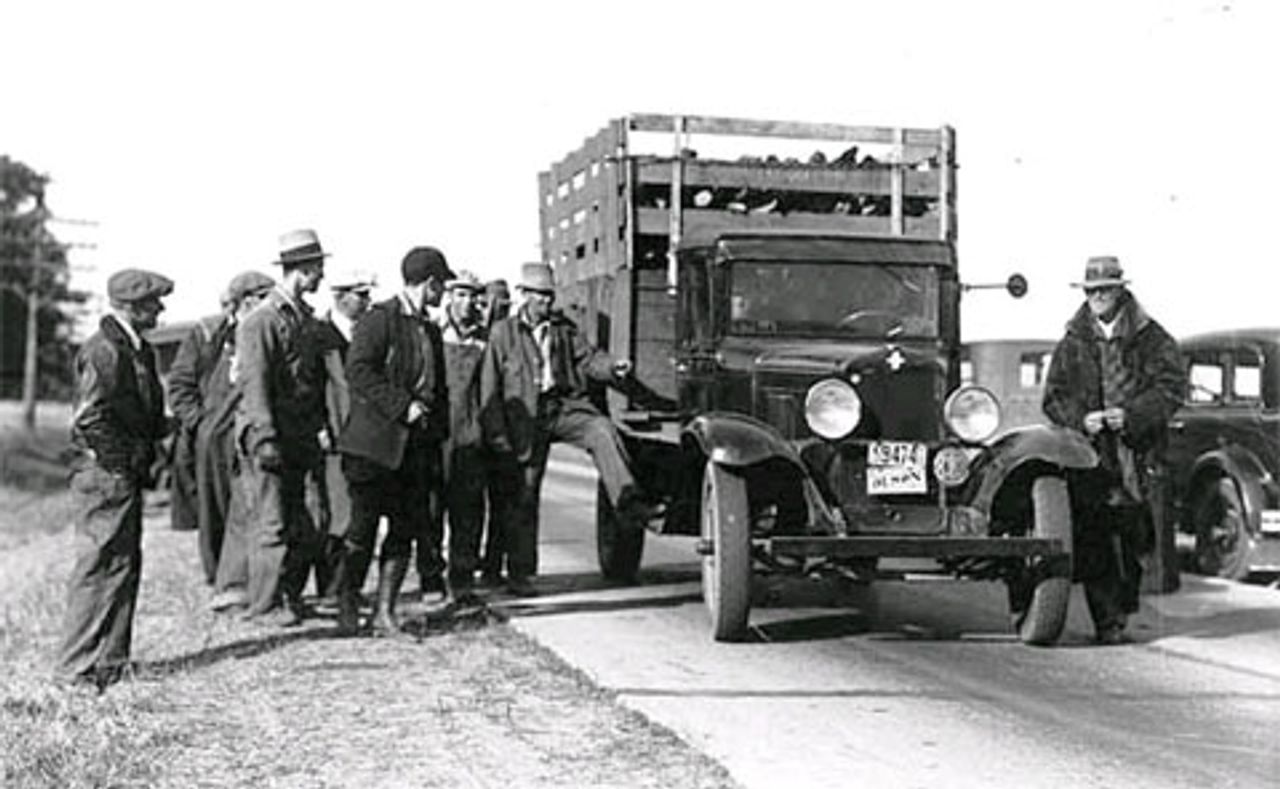 1932: National Farm Holiday Strike; Farmers picket roads into the Twin Cities to bar the transfer of farm products.
1932: National Farm Holiday Strike; Farmers picket roads into the Twin Cities to bar the transfer of farm products.The farm strike involved tens of thousands of farmers. Highways and railroad tracks into cities with major farm markets in Iowa, Nebraska, South Dakota and Minnesota were blockaded to bar the movement of farm produce in the hopes of creating scarcity and raising prices. Strikers halted farm foreclosures. Pitched battles with sheriff’s deputies took place, and some farmers were shot.
It is quite possible that truck drivers hauling farm produce into Minneapolis in 1932 had their loads dumped by angry farmers and remembered these tactics when they took to the streets in 1934. In the event, the National Farm Holiday Association became one of the big financial backers of the strike by Local 574, providing both money and food donations.
In Austin, Minnesota, some 90 miles south of Minneapolis, a young packinghouse worker named John Winkels joined the picket lines of farmers and helped stifle any movement of farm produce into the local market. Later, in 1933, Winkels led an occupation of the George A. Hormel & Company hog slaughtering facility.
Olson mobilized the National Guard and dispatched them toward Austin. Winkels and his fellow workers responded by sandbagging the entrance to the plant. “We went and got shotguns, rifles, pistols, sling shots, bullets, whatever we could get a hold of,” said Winkels. “We even got an old machine gun. We told the people we were ready for them—let them come.” [14]
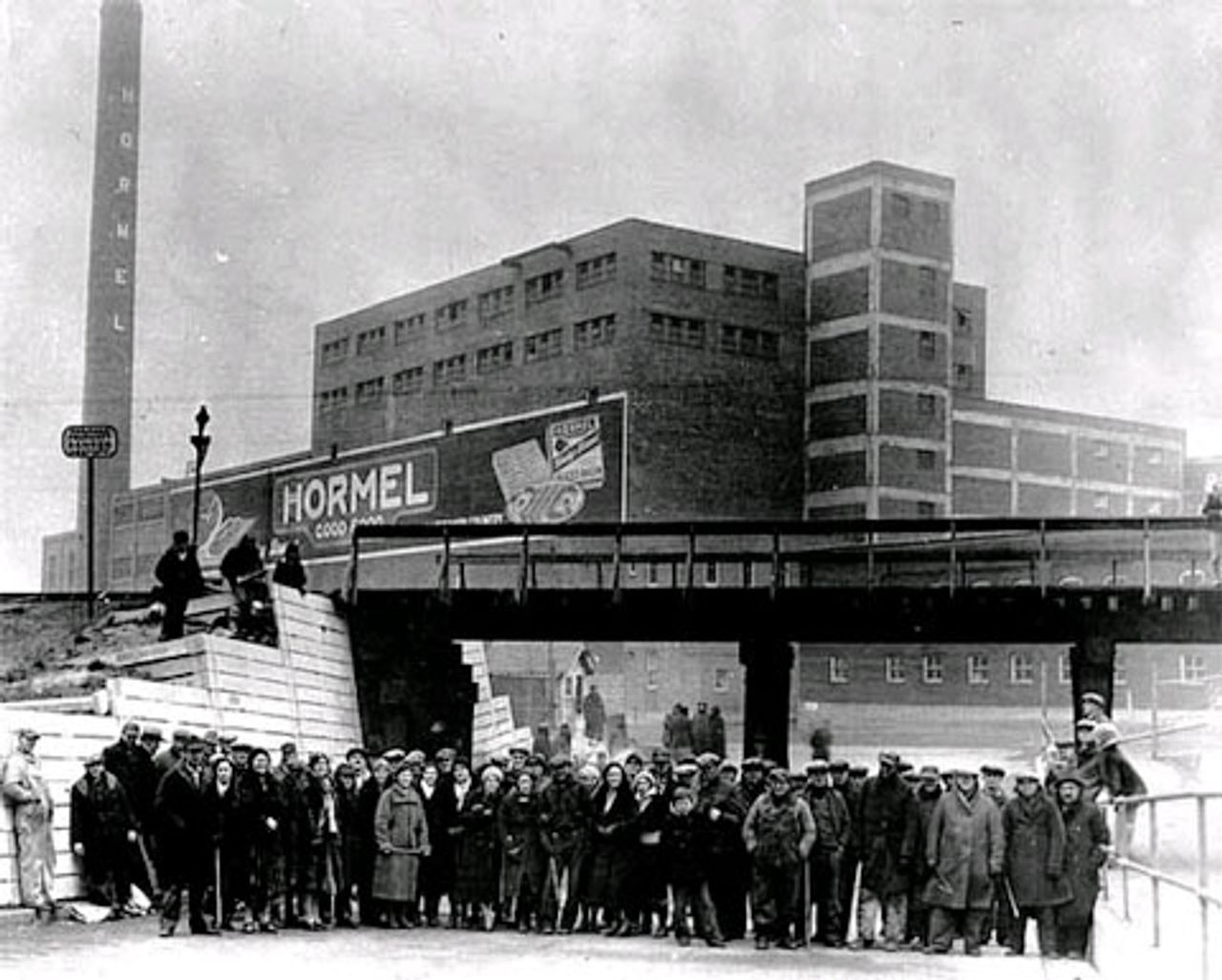 1933: Strike at Hormel Packing Plant, Austin.
1933: Strike at Hormel Packing Plant, Austin.Olson was able to defuse the struggle in Austin and get a settlement and union recognition. It was, however, one thing for the Farmer-Labor governor to cajole an isolated capitalist in rural Minnesota into compromise. It was quite another to reconcile the Citizens Alliance with mobilized strikers in Minneapolis.
The proliferation of farm and labor struggles caused Olson to move away from the conservatism of the early days of his administration. In 1933, he attempted to push through the legislature an unemployment insurance program.
The Citizens Alliance lashed out against the legislation as the “ultimate socialistic control of life and industry.” Olson attempted to reason with the opposition. He warned, “Industry, as such, being concerned largely with the sole motive of profit, has concerned itself little with the welfare of its workers.... It now remains for the state to do what industries failed to do.... This proposal is an attempt, whether wisely or not, to patch up the so called capitalist system—to prevent the substitution of socialization of industry.... If employers are not willing to take such steps, then inevitably some other system will have to be substituted.” [15]
May 1934
After the success of the February coal strike, the Trotskyists did not sit on their victory. They made a decision to expand beyond the coal yards and organize all workers across the transport industry, from drivers and their helpers, to dock or platform workers, to laborers inside the warehouses. They issued a leaflet that put forward two points to workers:
“DO YOU KNOW? That under Section 7-A of the N.I.R.A. workers are not only granted the right to organize, but are guaranteed the right to exercise this privilege without discrimination?”
“DO YOU KNOW? That the coal drivers of Minneapolis took advantage of this privilege to organize and through our organization gained a 25 percent wage increase?”
This sparked widespread interest among workers, who came knocking on Local 574’s door. The union moved quickly to flood the local with new members before Tobin, situated in Indianapolis, Indiana, could sabotage the operation.
Workers who had been laid off from the coal yards were also mobilized as organizers and given training as speakers to accelerate the campaign. The discussions with workers led to special meetings, the formalization of contract demands and a better understanding of the industry as a whole.
On April 15, the union went public with the results of its campaign by organizing a mass rally at a downtown theatre. More than 3,000 workers attended and signed up to join the union. A decision was made to take advantage of Governor Olson’s popularity, and more importantly to put him on record as supporting the strike, by inviting him to address the rally. Olson did not attend, but sent a subordinate to read a letter on his behalf. In part, it stated, “It is my counsel, if you wish to accept it, that you should follow the sensible course and band together for your own protection and welfare.” [16]
The union rented a giant garage that would serve as a central headquarters for the strike. A kitchen was set up to feed the strikers. A hospital staffed with volunteer nurses and a doctor was installed, making clear to everyone that the leadership had no illusions that the struggle could be won without a fight. Mechanics were recruited to maintain the fleet of 450 vehicles that would be used to dispatch pickets during the strike.
All members of the Communist League branch in Minneapolis were drawn into the preparations for the coming strike. They spearheaded the organization of the city’s 30,000 unemployed so as to neutralize the possibility of their being used as strikebreakers, and drew the best elements of them into the ranks of the strikers.
 Women’s Auxiliary serving pickets at strike headquarters commissary
Women’s Auxiliary serving pickets at strike headquarters commissaryThey also organized a woman’s auxiliary, drawing in the wives of strikers and supporters to provide clerical support and staff the hospital and kitchen. At the height of the strike, some 10,000 workers and their families ate in the commissary in a single day. The auxiliary played a critical role as the strike dragged on, leading demonstrations of up to 700 women on city hall, pressuring landlords to back off from evicting strikers who fell behind on rent, and picketing offices of the capitalist press to protest lies and falsifications that aided the employers.
The strike force was divided into units, and the most able workers were designated as picket captains. Special squads composed of the best fighting elements of the union were held in reserve, so as to be ready for dispatch at critical moments. Motorcycle couriers provided contact across the far-flung field of struggle, and car patrols swept through neighborhoods looking for scab trucks and notifying strike headquarters.
The strike begins
Union contract demands were rejected by the trucking companies, and on March 15, Local 574 voted unanimously to strike the following day.
In the opening days, cruising pickets shut down trucking, while more and more transport and inside workers joined the union, swelling its ranks to 6,000. Police were active, arresting some 169 workers in the first four days. Fines were as high as $50 per worker, and some were sentenced to the workhouse for 10-45 days.
The Minneapolis Tribune warned on the fifth day of the strike: “The city’s food supply began to feel the pinch of the strike...a general shutdown of bakeries is estimated to be only a day away. In groceries, similar conditions existed....” [17]
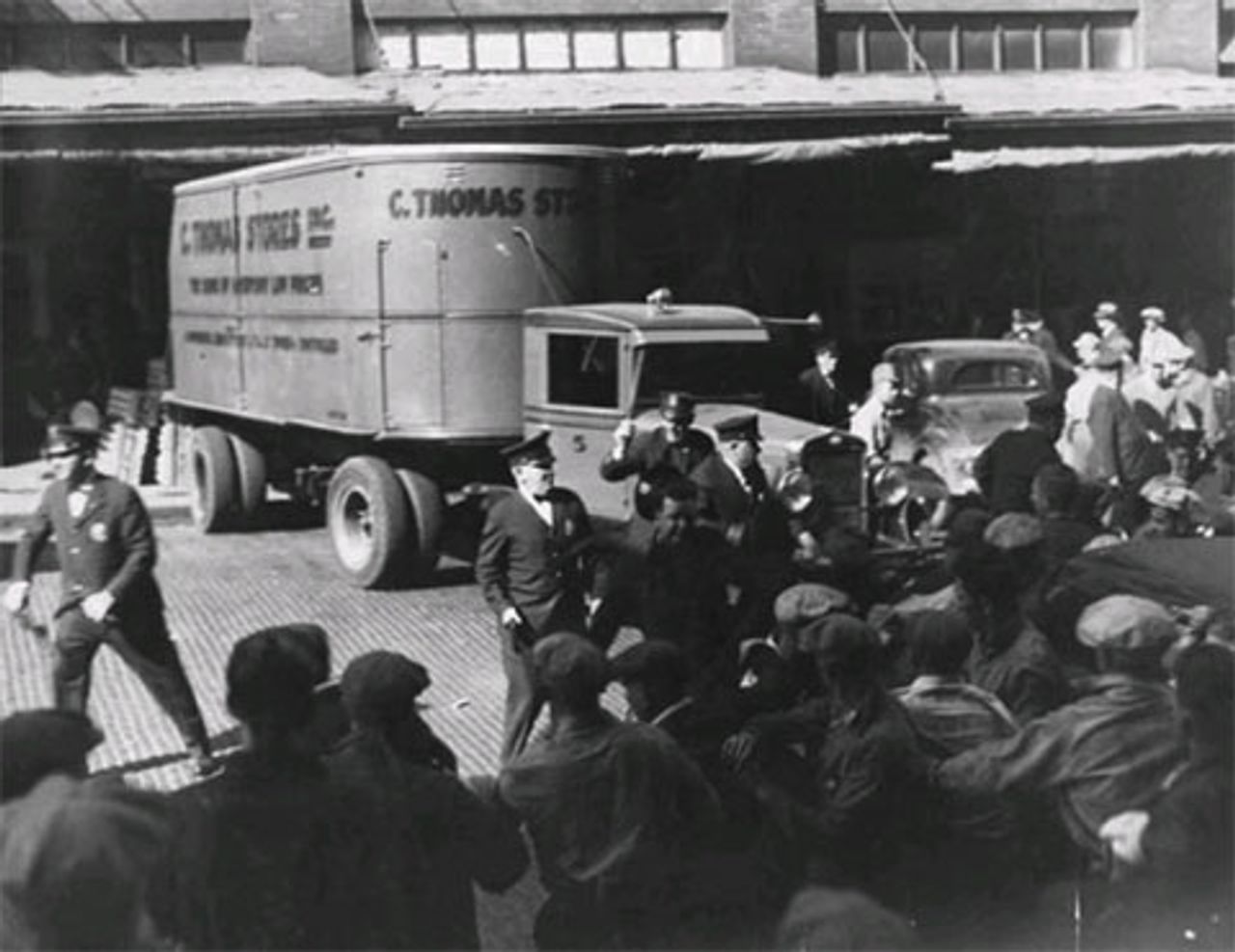 Police moving trucks against unarmed pickets
Police moving trucks against unarmed picketsOn May 19, large numbers of police were organized to protect the movement of trucks. Strikers, using only their bare hands, engaged in some of the first serious fighting. Later that evening, a company spy who had worked his way into the union strike headquarters was able to dispatch three truckloads of pickets to a pre-arranged location where police and Citizen Alliance deputies were waiting. He managed to convince a group of women to accompany the strikers.
When the pickets arrived the trap was sprung and all were beaten mercilessly. Carl Skoglund described the scene: “I remember the night. They brought the women in, and the other pickets from the Tribune Alley, and laid them down in rows in strike headquarters. All the women were mutilated and covered with blood, two or three with broken legs; several stayed unconscious for hours. Saps and night clubs had been used on both the men and women.” [18]
In past struggles, such use of violence by police and thugs had cowed workers. This time, the incident ignited the ranks of strikers, who quickly armed themselves with every sort of club they could muster. The stage was set for the colossal battles of May 21 and 22 that would go down in history under the name “Deputies Run.”
On the one side, hundreds of police and Citizens Alliance deputies, primarily businessmen, congregated in the market. The cost of deputies for the Citizens Alliance in the May strike would run from $75,000 to $100,000.
The union deployed some 500 pickets and kept 900 workers at strike headquarters in reserve. Throughout the night, another 600 strikers had secretly infiltrated by groups of three into the AFL headquarters next to the warehouse district. With the first movement of trucks, the secreted union forces burst out and the melee begin. As the battle raged, deputies took flight, leaving the police to absorb the full onslaught, and some 30 had to be hospitalized.
The following day, Minneapolis Police Chief Michael Johannes called on the American Legion to provide 1,500 recruits and scoured the jails for potential thugs who could be enlisted. Additional deputies were provided by the Citizens Alliance.
On the other side, members of the building trades and electrical workers came out in sympathy strike and joined the army of Local 574. Some 20,000 to 30,000 people, including spectators, packed the downtown market district waiting for the fight to begin. A local radio station set up portable equipment to provide a blow-by-blow account of the fight. Again, the first movement of produce detonated the battle.
Historian William Millikan has pieced together an account of the day culled from reports submitted by deputies of the Citizen Alliance:
“Following their battle plan, several thousand angry pickets retreated south on First Avenue to Seventh Street, where they wheeled and marched west toward the railroad tracks. Reinforced by three truckloads of armed strikers, the force met a small police line stretched across the corner at Seventh Street and Third Avenue between the Weisound Malt & Beer Company and the Minneapolis Anoka & Cuyuna Range Railroad passenger depot.
“While the 23 police officers briefly stalled the march, the special deputies posted on the northeast corner of the intersection were advised to flee into the market. Leaderless and outnumbered fifty-to-one, the businessmen quickly retreated from the battleground. One deputy overheard a well-dressed striker comment, ‘We are getting the rats down in the hole where we want them.’
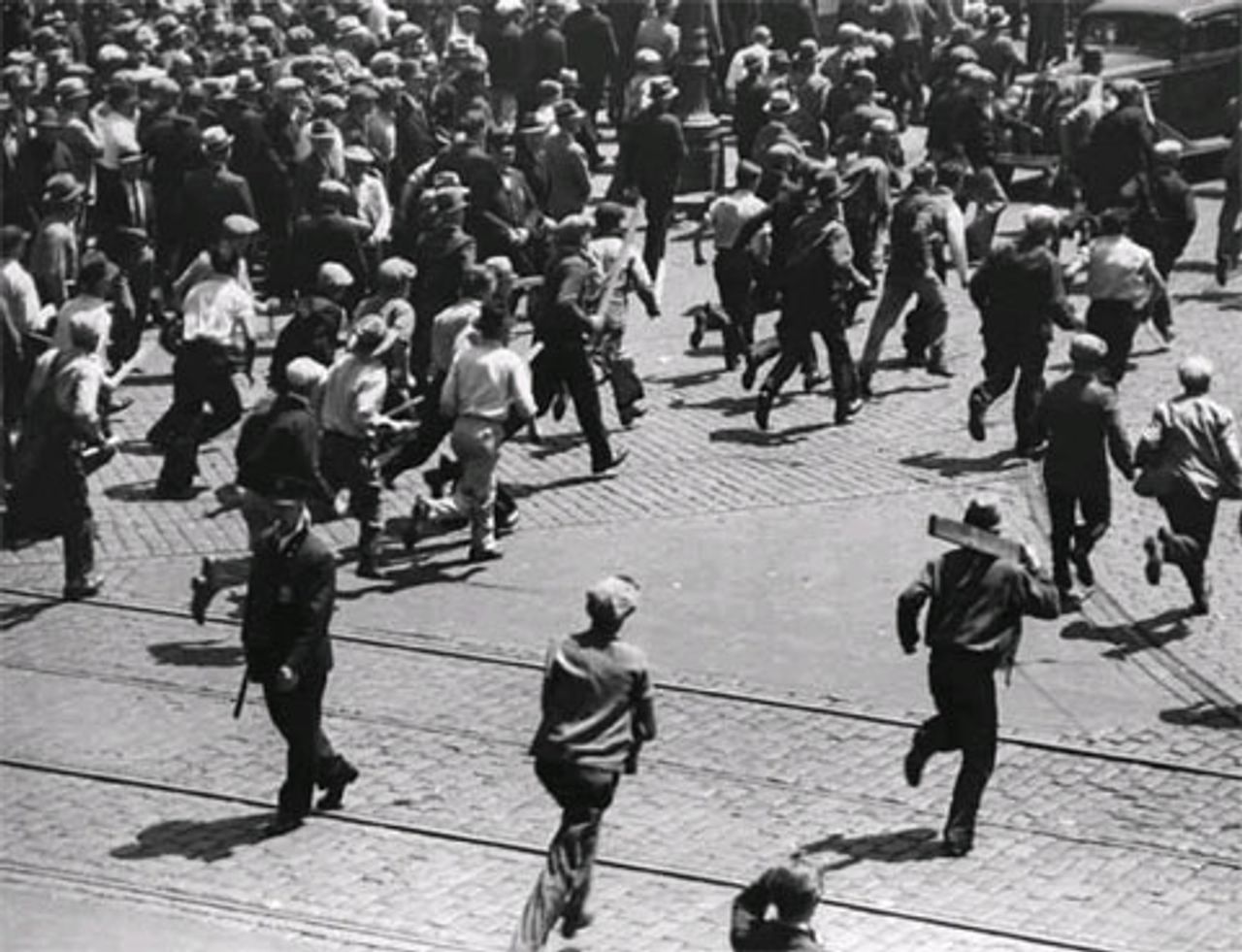 May 21: Strikers go into action against Citizens Alliance deputies
May 21: Strikers go into action against Citizens Alliance deputies“Three squads watched nervously from the alley in front of the Gamble-Robinson Company as the mob ‘broke loose and came down Third Avenue like a bunch of hyenas.’ As the pickets rushed down Third Avenue at a run, the special deputies retreated into their alley. Within minutes, shouts of ‘here they come’ were heard from in front of Ryan Potato Company on Third and Sixth Street. CA [Citizens Alliance] Director Arthur Lyman yelled to several squads and led them forward to defend the corner. As the crowd swept down Third Avenue, ‘they appeared to be beyond any sense of reason and were certainly one hundred percent in a wild rage.’ The real battle for control of the Minneapolis market district was about to begin.
“A mass of several thousand angry strikers poured into Sixth Street in the next ten minutes, filling the street and even covering the awning roof on the market side of the street. The CA’s army retreated under an aerial bombardment of bricks, bottles, fruit boxes, sticks, two-by-fours, and steel rods. Deputies, cut or bleeding or unconscious, were dragged off the street as the strikers overtook the retreating army.
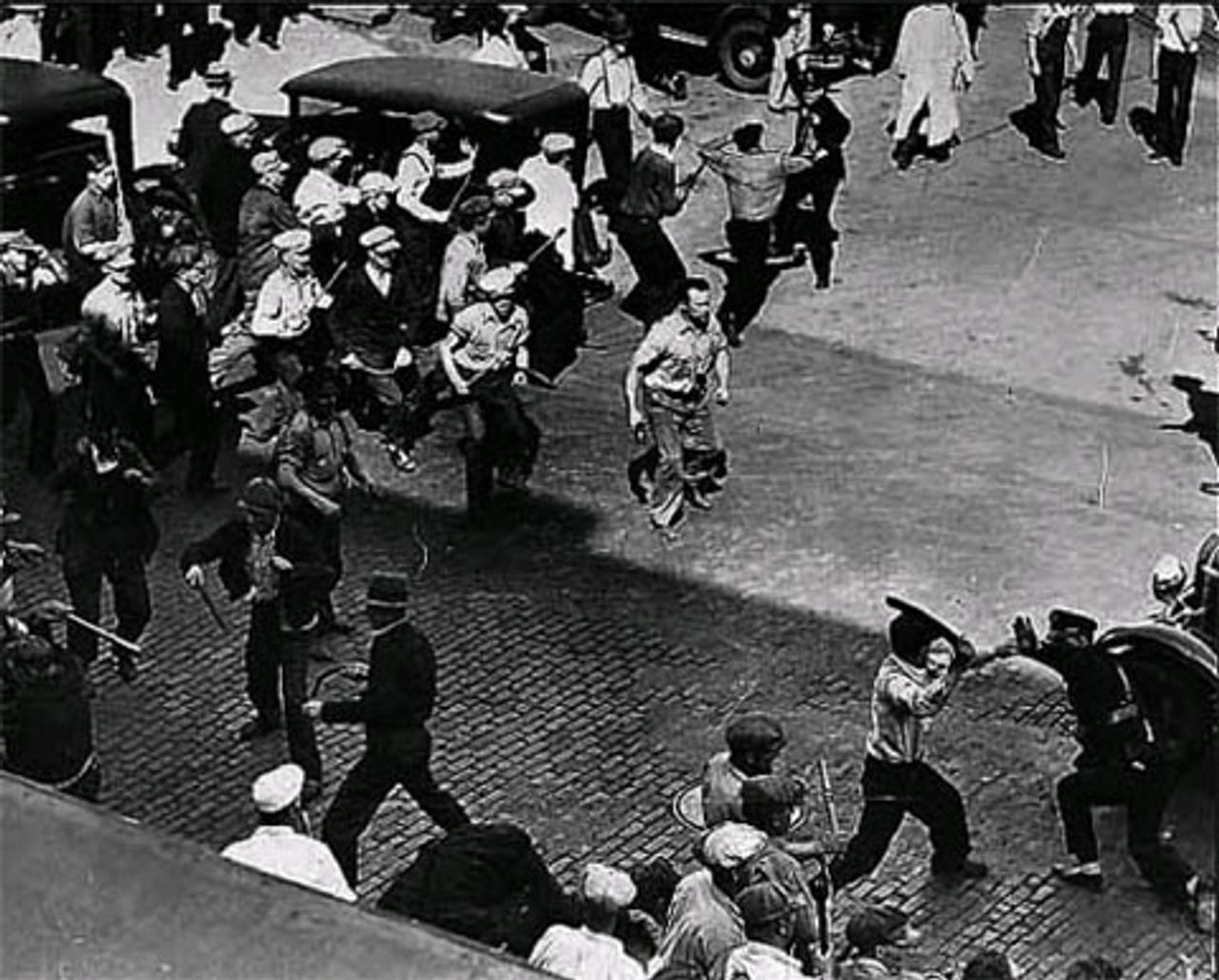 Street fighting in warehouse district
Street fighting in warehouse district“In vicious hand-to-hand fighting, more deputies were clubbed to the ground by hoses, lead pipes, baseball bats, and iron hooks. When an injured deputy still displayed his badge, he was clubbed unconscious. Bloodied deputies crawled or were dragged into the buildings lining Sixth Street or rolled under vehicles in a desperate attempt to escape the ferocity of the strikers. One deputy realized that the truck drivers ‘took a terrible grievance towards us and were angered beyond mad men.’
“As the strikers bore down on them, one of the deputies shouted above the din at nearby police officers: ‘For God’s sake get your gun out. They are going to kill us!’...
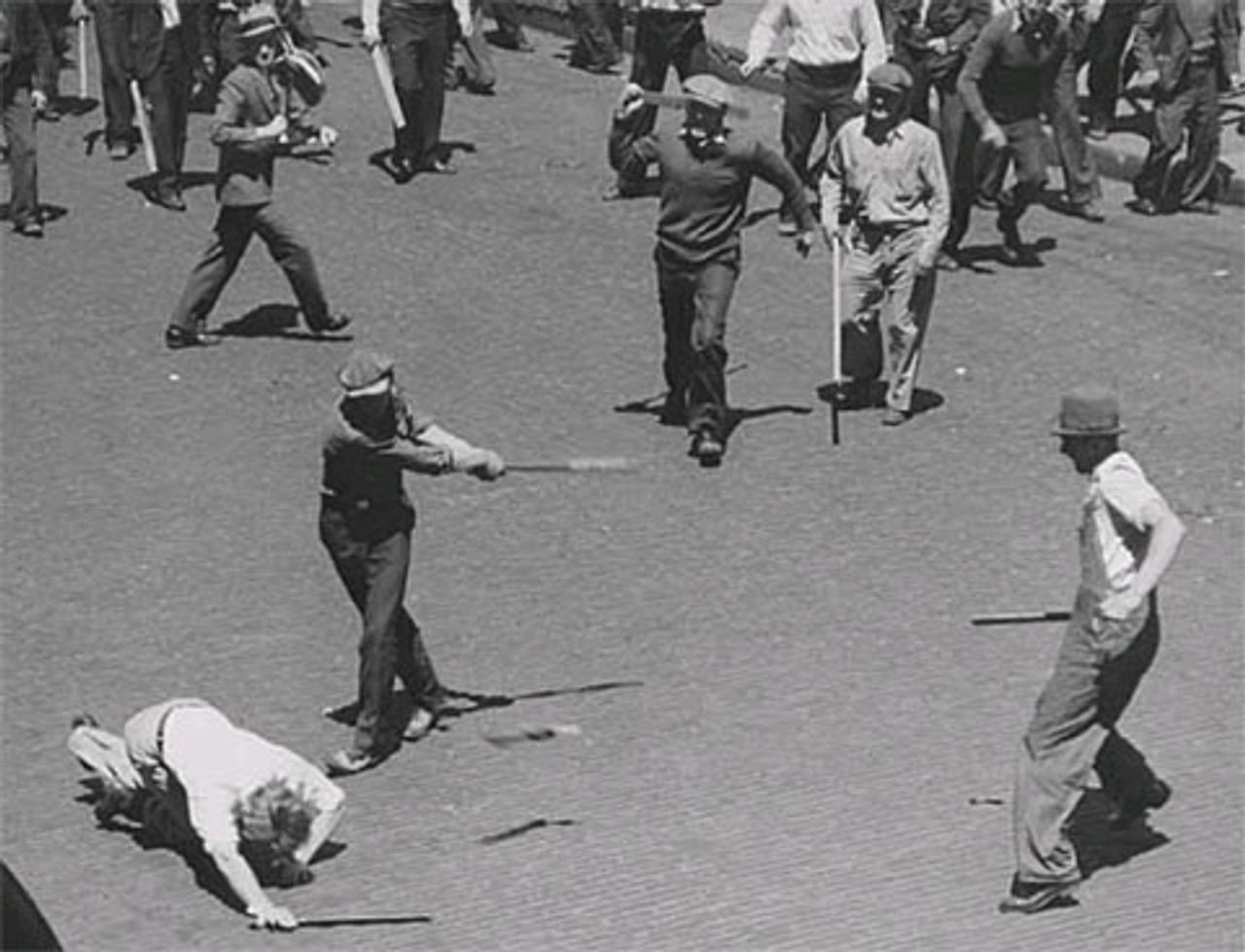 May 21: Worker takes down a Citizens Alliance deputyAs the CA’s army retreated down Sixth Street, Arthur Lyman, vice president of the American Ball Company and a CA director, rallied twenty deputies to help the men in the front lines escape. ‘Give the poor chaps a chance,’ he called. Within minutes, Lyman was trapped in the frenzy of swinging clubs. A small, sickly-looking man in dirty coveralls struck him on the head. Dazed, Lyman was thrown over an automobile and worked over with clubs and fists. His unconscious body dropped to the street by the alley, lying there until an improvised ambulance could pick him up...
May 21: Worker takes down a Citizens Alliance deputyAs the CA’s army retreated down Sixth Street, Arthur Lyman, vice president of the American Ball Company and a CA director, rallied twenty deputies to help the men in the front lines escape. ‘Give the poor chaps a chance,’ he called. Within minutes, Lyman was trapped in the frenzy of swinging clubs. A small, sickly-looking man in dirty coveralls struck him on the head. Dazed, Lyman was thrown over an automobile and worked over with clubs and fists. His unconscious body dropped to the street by the alley, lying there until an improvised ambulance could pick him up...
“Isolated, without any leadership, vastly outnumbered, and viciously outfought by the strikers, the demoralized deputies broke ranks and ran to protect themselves.” [19]
Both police and deputies disappeared from the district and pickets took up positions directing traffic. It was a complete rout. The event electrified workers across the country.
“Newsreels, which were then a feature of motion picture entertainment, showed combat scenes filmed during the Tuesday battle. Workers everywhere reacted enthusiastically to the news. Audiences in movie houses broke out in cheers at the sight of pickets clubbing cops for a change, since in most strikes it was entirely the other way around.” [20]
The significance of the battles of May 21-22, considered alongside other major strikes by autoworkers in Toledo, Ohio, and longshoremen in San Francisco, was summed up by James P. Cannon:
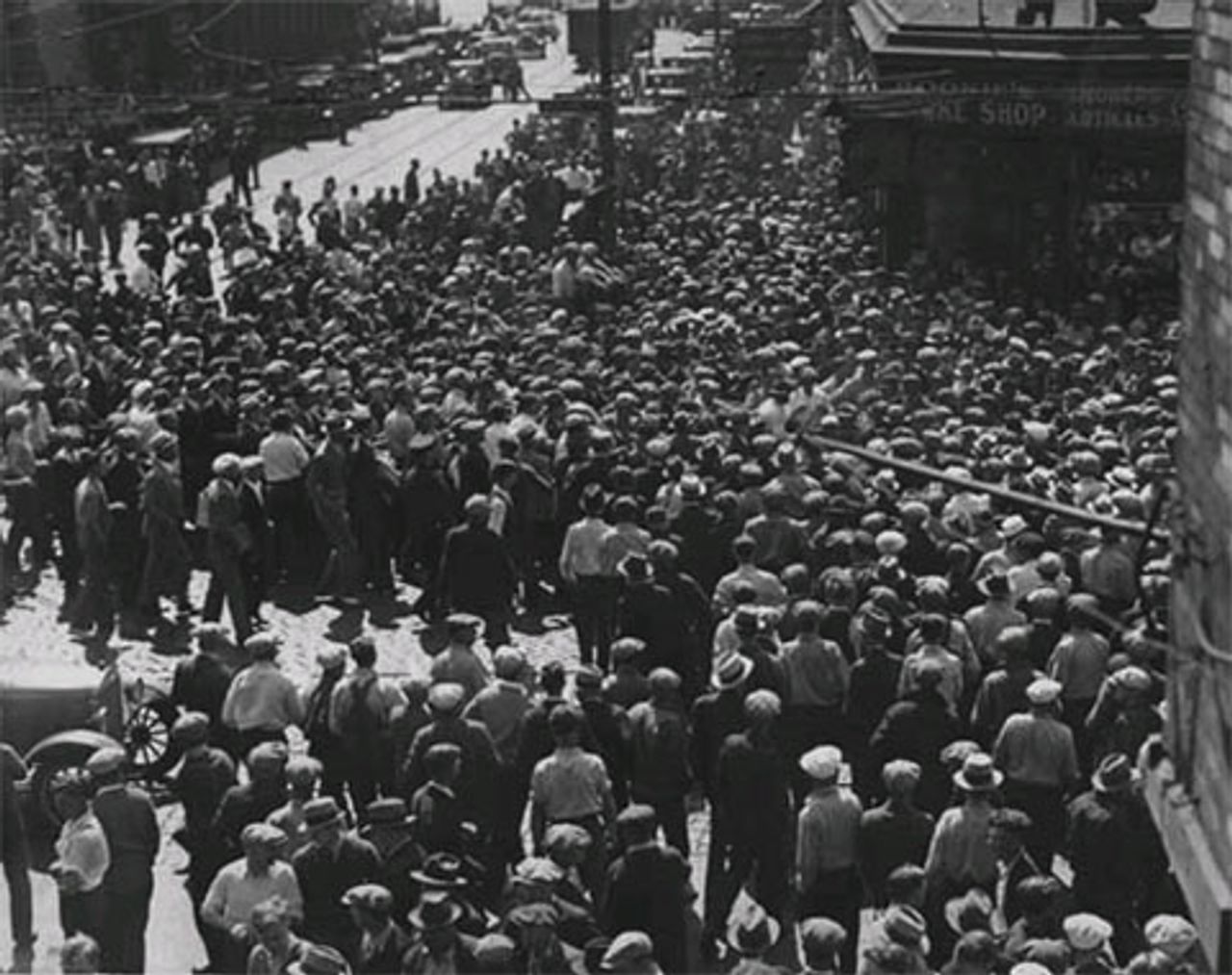 20,000 to 30,000 people pack the warehouse district
20,000 to 30,000 people pack the warehouse district“The messianic faith in the Roosevelt administration which characterized the strike movement of a year ago and which, to a certain extent, provided the initial impulse for the movement, has largely disappeared and given place to skeptical distrust.... [T]he striking workers now depend primarily on their own organization and fighting capacity and expect little or nothing from the source to which, a short year ago, they looked for everything.... What has actually taken place has been a heavy shift in emphasis from faith in the NRA [Roosevelt’s National Recovery Act] to reliance on their own strength.” [21]
AFL officials in Minneapolis were especially nervous about these developments. They did not want the strike to be resolved by the independent movement of the workers, but rather to fall under the control of Governor Olson. They met with city officials in an effort to end the street fighting and bring in the Farmer-Labor governor. Republican Mayor A.G. Bainbridge requested that Olson mobilize the National Guard, which he did, although the units were kept just outside the city at this point. Local 574 immediately denounced the calling up of the guard and organized a mass rally of the city’s workers.
A tempestuous series of negotiations was begun that ultimately compelled 166 companies to recognize the union and accept the return to work of all workers, including those the employers wanted to victimize for “crimes” during the strike. Seniority was also recognized, and some ambiguous language was inserted concerning the recognition of inside workers. Future wages, however, were left to arbitration.
Nevertheless, the strike leaders believed that the agreement constituted a basis from which future gains could be registered and recommended the membership accept. On May 31, the agreement was signed and workers soon returned to their jobs.
Up until this point, Cannon and the leadership of the Communist League in New York had provided backing to the strike by phone contact. But Cannon recognized in the situation the necessity of throwing the whole party behind the struggle in Minneapolis. He came out to Minneapolis, followed soon after by other key members of the party, to expand the political and practical organization of the struggle. Among those who went to Minneapolis were Max Shachtman and party lawyer Albert Goldman.
Within two weeks of the settlement, the Citizens Alliance recovered its balance and began to work toward undoing the victory of the workers in the May strike. Arbitration on future wage increases broke down and negations over the inclusion of inside workers in the union were frustrated.
Governor Olson, having earlier committed himself to support the inclusion of inside workers, backtracked and said it would have to be arbitrated. The Regional Labor Board backed the Citizens Alliance and denied the union representation of the inside workers.
Employers shorted workers on wage increases won back in the February settlement, and individual workers were fired. Seniority was violated. Some workers were given wage increases in the hopes of further dividing the ranks. In all, Local 574 recorded 700 grievances over the course of a relatively short period. Preparations began for a new strike.
Notes:
10. James P. Cannon, The History of American Trotskyism (Pathfinder, 1972), p. 47.
11. Farell Dobbs, Teamster Rebellion (Anchor Foundation, Inc., 1972) p. 34.
12. Art Preis, Labor’s Giant Step: Twenty Years of the CIO (Pioneer Publishers, 1964) p. 41.
13. Luoma, pp. 16-17.
14. Interview with Pioneer Packinghouse Organizer: How Sitdown Won First Hormel Strike (Bulletin, September 10, 1985) p. 8.
15. Millikan, pp. 256-57.
16. Dobbs, p. 65.
17. Charles Rumford Walker, American City: A Rank-and-File History (Farrar & Rinehart, New York) p. 105.
18. Walker, p. 108.
19. Millikan, p. xxix-xxx.
20. Dobbs, p. 92.
21. James P. Cannon, The Communist League of America 1932-34 (Anchor Foundation, Inc., 1985) pp. 334-35.
